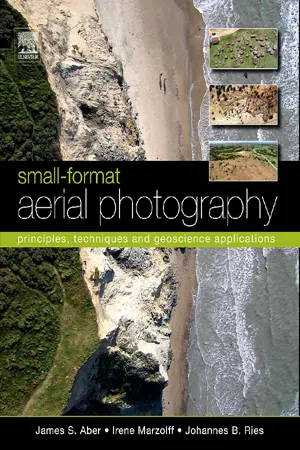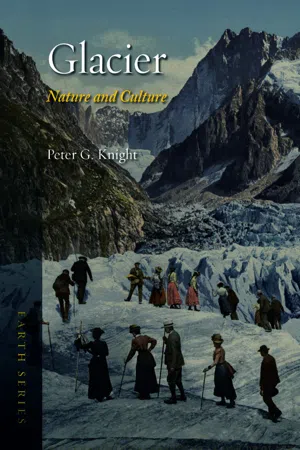Glacial Erosion
Glacial erosion refers to the process by which glaciers carve and shape the land through the movement of ice and meltwater. This process involves the plucking and abrasion of rock and sediment, resulting in the formation of features such as cirques, arêtes, and U-shaped valleys. Glacial erosion significantly impacts the landscape, shaping it over long periods of time.
5 Key excerpts on "Glacial Erosion"
- eBook - ePub
Small-Format Aerial Photography
Principles, Techniques and Geoscience Applications
- James S. Aber, Irene Marzolff, Johannes Ries(Authors)
- 2010(Publication Date)
- Elsevier Science(Publisher)
...Chapter 12 Glacial Geomorphology 12.1. INTRODUCTION Modern glaciers and ice sheets cover approximately 10% of the world’s land area. Of this, most glacier ice is found in Antarctica and Greenland with all other areas accounting for only about 5% of the total. During the Ice Age (Pleistocene Epoch) of the last one million years, glaciers and ice sheets expanded dramatically and repeatedly over large portions of northern Eurasian and North American lowlands and in mountains and high plateaus around the world. At times, the volume of glacier ice during the Pleistocene was at least triple that of today (Hughes et al., 1981). Global sea level declined by at least 120 m, which allowed ice sheets to spread over broad continental shelves, particularly north of Eurasia (Svendsen et al., 1999; Polyak et al., 2000). Geomorphology is the study of the Earth’s surficial landforms both on land and on the seafloor. This study is both descriptive and quantitative; it deals with morphology, processes, and origins of landforms. Glacier ice is a powerful agent that created many distinctive landforms that are well preserved nowadays in regions of former ice expansion. Glaciers modify the landscape in three fundamental ways by erosion, deposition, or deformation (Fig. 12-1). A given site may be subjected to each or all of these processes during the advance and retreat of a glacier, and repeated glaciation may overprint newer landforms on older ones. In addition, glacial meltwater is also an effective geomorphic agent that may erode or deposit conspicuous landforms in connection with glaciation. The results are complex landform assemblages that represent multiple glaciations during the Pleistocene. Aerial photography has long been utilized to illustrate, describe, interpret, and map the diverse types of landforms created by glaciation (e.g. Gravenor et al., 1960)...
- eBook - ePub
- Simon Bell(Author)
- 2012(Publication Date)
- Routledge(Publisher)
...Ice continues to erode high mountains and parts of some lands such as Iceland, Greenland and Antarctica (Figure 6.18). The erosive power of ice is very great, ranging from the widespread effects of continental ice sheets many hundreds of metres thick to major and minor valley and corrie glaciers, gouging out large valleys as well as eroding rock surfaces at the small scale. At a grand scale, the interaction of ice sheet movement across the ancient Precambrian rocks of the vast Canadian Shield and northern Siberia left behind an undulating topography. From 10,000 metres high, travelling in a transcontinental airliner, the view shows a defi- nite grain or directional pattern to large areas of this tundra, land where the subsoil remains permanently frozen (Figure 6.19). The pattern partly reflects the directional flow of the ice and the underlying rock structure, where weaknesses have been exploited by the ice. This erosive landform also contains depositional patterns of drumlins (linear deposits of eroded material). This extensive pattern has had a major effect on the drainage pattern and microclimate affecting vegetation distribution. In order to see the way in which the process of glaciation works under different conditions, such as latitude, elevation and aspect, it is useful to examine an area where all of these variables can be observed. Such a place is the Cascade Mountains, running from California northwards to British Columbia, which were discussed earlier in relation to landform creation through plate tectonics and vulcanism. The Cascade Mountains contain many peaks high enough to accumulate sufficient snow to compress into a hard-packed form (firn) that eventually turns into granular ice, under the pressure of its own weight, and starts to flow downhill under gravity. For example, Mount Rainier supports twenty-six glaciers, each of which is the source of a major river in the region...
- eBook - ePub
Glacier
Nature and Culture
- Peter G. Knight(Author)
- 2019(Publication Date)
- Reaktion Books(Publisher)
...1 Ways of Thinking about Glaciers A perennial mass of ice, and possibly firn and snow, originating on the land surface by the recrystallization of snow or other forms of solid precipitation and showing evidence of past or present flow. 1 Today, from a distance, I saw you walking away, and without a sound the glittering face of a glacier slid into the sea. 2 Precisely defined for the scientist, a metaphor and an icon for the poet, glaciers for each of us have their own place in our view of the world. Human life has developed in an unusual period of Earth’s history: a period in which there are glaciers. Of the history of the planet, glaciers have been here, on and off, for only about 15 per cent of the time, but they have been here throughout the 2 million years of human history and prehistory. However, only for the last century have we lived in an age in which the importance of glaciers has been acknowledged. It is less than two hundred years since the idea was first widely accepted that ice ages come and go, and that glaciers used to cover much more of the Earth’s surface than they do now. We have only just noticed that we are living in a glacial period. We live now, for the first time, in a cultural ice age as well as a physical one. Few of us consciously place ‘glacier’ at the heart of our view of the world but we do now appreciate the key role of glaciers both in the planet’s past – creating the landscapes that surround us – and in its future, as major players in the unfolding drama of climate change. But at the same time that we noticed glaciers we also realized that the physical ice age may be coming to an end, that we are losing the glaciers, and that it may be our fault that we are losing them so fast. Because we recognize the importance of glaciers in the global system we now have a particular view of the world, different from that of the generations before us...
- eBook - ePub
- Ro Charlton(Author)
- 2007(Publication Date)
- Routledge(Publisher)
...This is transported downslope, under the force of gravity, by processes of mass wasting. These include rapid mass movements, such as slides and debris flows, together with the much slower processes of creep and solifluction. Sediment is also produced by the erosive action of water, ice and wind. Processes of water erosion include rain splash, sheetwash, rilling and gullying. Soil erosion is a natural process, but it can be accelerated by human activity, with rates of soil removal exceeding rates of soil formation. Accelerated soil erosion is a major environmental problem worldwide. In order to assess rates of soil loss, various monitoring techniques are used. Models have also been developed to simulate erosion and soil loss. FURTHER READING Introductory texts Kirkby, M.J., 2005. Hillslope processes and landscape evolution. In: J. Holden (ed.), An Introduction to Physical Geography and the Environment. Pearson Education., Harlow, pp. 249–77. Covers weathering and mass movement in slightly more detail than is provided here. Summerfield, M.A., 1990. Global Geomorphology: An Introduction to the Study of Landforms. Longman, Harlow. Good, clearly written chapters on weathering and slope processes. More advanced texts Morgan, R., 2005. Soil Erosion and Conservation. Blackwell, Oxford. Comprehensive coverage of soil erosion processes, monitoring and modelling, and management. Poesen, J. et al., 2002. Gully erosion in dryland environments. In: L.J. Bull and M.J. Kirkby (eds), Dryland Rivers: Hydrology and Geomorphology of Semi-arid Channels. John Wiley & Sons., Chichester, pp. 229–62. Provides a summary of current understanding of gully erosion in dryland environments. Web sites The Soil Erosion Site, www.soilerosion.net. Here you will find a wide range of material relating to all aspects of soil erosion. With contributions from nearly 50 soil erosion experts, the site includes background information, links to photos and videos, and more specialist material....
- eBook - ePub
The Global Casino
An Introduction to Environmental Issues
- Nick Middleton(Author)
- 2018(Publication Date)
- Routledge(Publisher)
...CHAPTER 14 Soil erosion Learning Outcomes At the end of this chapter you should: Understand that soil is a resource that provides many ecosystem services. Appreciate that many drivers, both natural and societal, contribute to the occurrence of soil erosion. Recognize the variety of ways in which soil erosion can be measured. Appreciate the wide range of environmental impacts associated with the movement of soil. Be familiar with the three approaches to soil conservation. Understand the sorts of issues that hinder implementation of soil conservation measures. Key Concepts tillage erosion, erosivity, erodibility, sediment delivery ratio. Universal Soil Loss Equation (USLE), Global Assessment of Human-Induced Soil Degradation (GLASOD), mulching, zero-tillage, shelter belt Soil erosion is a natural geomorphological process that occurs on most of the worlds land surface, with the principal exception of those areas on which soil eroded from elsewhere is deposited. This movement of soil is usually slow, only infrequently occurring in dramatic events, so perception of its seriousness, measurement of its progress and persuasion of the need to take ameliorative action are not always regarded as a priority, A fundamental distinction is made between natural or geological soil erosion - a phenomenon that forms an integral pathway in numerous biogeochemical cycles - and rates that are accelerated by human activity, and it is accelerated erosion that has received most scientific attention. Such attention is not new, however...




